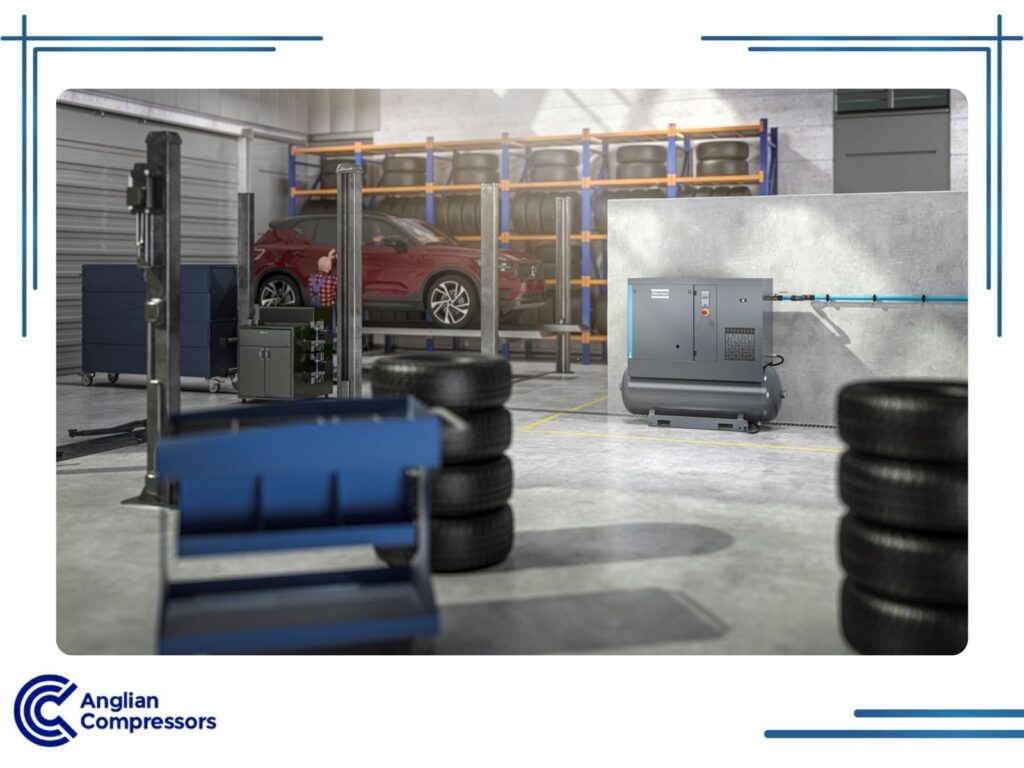How Do Centrifugal Compressors Work?
Your Guide to Compressed Air Piping Systems
Did you know that centrifugal compressors are at the heart of numerous industries, powering everything from refrigeration systems to natural gas processing plants?
These remarkable machines operate on the principle of converting kinetic energy into potential energy, but have you ever wondered how they achieve such impressive efficiency? Join us as we unravel the mysteries behind centrifugal compressors and explore their crucial role in today’s industrial landscape.
So, let’s dive in!
Table of Contents
What Is a Centrifugal Compressor?
A centrifugal compressor, often described as a ‘radial compressor’, is a machine designed to compress and move fluid radially by converting rotational energy into pressure energy. It stands apart from its peers in terms of functionality, efficiency, reliability, and maintenance requirements.
Components of a Centrifugal Compressor
Let’s dissect the anatomy of a centrifugal compressor:
- Inlet: Think of it as the gateway where air first enters the system.
- Impeller: Centrifugal compressor impellers spin rapidly to transfer energy from the motor to the air, accelerating it outwards.
- Radial blades: These are the blades attached to the impeller that increase the kinetic energy of the air.
- Diffuser: This part diffuses, or spreads out, the fast-moving air, slowing it down and converting the kinetic energy into pressure.
- Volute/Collector: This is the final stage where the now pressurised air is collected and directed towards the outlet.
- Discharge Flange: This is the outlet where the compressed air exits.
- Other integral parts include bearings, casings, and nozzles that collectively ensure the smooth operation of any centrifugal compressor stage in a system.
How Does a Centrifugal Compressor Work?
Here’s a simplified step-by-step cycle of the centrifugal compressor working principle:
- Air enters through the inlet and reaches the centrifugal impeller.
- The impeller forces the air outwards using centrifugal force.
- The fast-moving air enters the diffuser, which converts it’s kinetic energy into pressure.
- The volute then collects the pressurised air and directs it to the outlet.
What can you expect from a single-stage centrifugal air compressor?
- Capacity: The compressor offers a flow rate of up to 1,500 cubic feet per minute (cfm), sufficient to meet the needs of most industrial applications.
- Pressure: It can deliver a discharge pressure of up to 125 pounds per square inch gauge (psig), making it a robust choice for heavy-duty operations.
- Efficiency: Atlas Copco’s compressors are known for their energy efficiency, with models boasting an isentropic efficiency of up to 85%.
- Operating Speed: The rotational speed of the impeller can reach up to 60,000 revolutions per minute (RPM), ensuring rapid compression and air delivery.
- Temperature: The operational temperature range for popular models extends from -20 to 40 degrees Celsius, demonstrating versatility in various climate conditions.
Remember, these are typical figures, and actual performance may vary based on ambient conditions, maintenance, site and operational demands.
Multi-Stage Compression
In multi-stage centrifugal air compressors, the compression process spans multiple impeller-diffuser combinations. Each stage independently contributes to the overall pressure rise, resulting in a more efficient compression, and a higher discharge pressure.
Let’s break down the process:
- Initial Compression: Air enters the first stage – the initial impeller, which accelerates the air rapidly. The air then moves into the diffuser, where it’s speed decreases, and in return, its pressure increases.
- Intermediate Cooling: After the first stage, the air often goes through an intercooler – a device that cools the air to reduce the work required for subsequent compression stages. Cooling the air also minimises the risk of reaching the temperature limits of the compressor materials.
- Subsequent Compression Stages: The cooled, compressed air then enters the next stage – the second impeller and diffuser. This stage repeats the same process, further increasing the pressure of the air. If more stages are present, the air continues through them, and each stage pressurises the air more.
- Final Discharge: After passing through all the stages, the high-pressure air is finally discharged through the outlet.
So, why use multi-stage compression instead of single-stage? Firstly, it’s more energy-efficient, as it reduces the work done per unit of air. Secondly, it allows for higher pressure ratios, which is key in many industrial applications. Additionally, the intercooling between stages helps prevent overheating, increasing the safety and lifespan of each centrifugal compressor.
Let’s consider a standard multi-stage centrifugal air compressor and it’s performance data:
- Capacity: A multi-stage compressor can offer a high flow rate of up to 20,000 cubic feet per minute (cfm), ensuring a steady supply of compressed air for large-scale industrial applications.
- Pressure: These compressors can deliver a high discharge pressure reaching up to 300 pounds per square inch gauge (psig). This higher pressure makes them suitable for heavy-duty operations that single-stage compressors might be unable to handle.
- Efficiency: Atlas Copco multi-stage compressors are known for their improved efficiency. The intercooling process between stages reduces the work required for compression, increasing overall isentropic efficiency to levels as high as 86%.
- Operating Speed: The rotational speed of impellers in a multi-stage compressor can reach up to 70,000 revolutions per minute (RPM), ensuring swift and efficient air compression.
- Temperature: The operational temperature range for a multi-stage compressor can extend from -40 to 50 degrees Celsius.
Please note that these are general figures; actual performance may vary based on ambient conditions and specific operational requirements.
Efficiency and Performance
Several factors can affect the efficiency of a centrifugal compressor, for example, design, external conditions like inlet temperatures, and operational parameters. Generally, they operate within a 70-85% efficiency range, making them a preferred choice for many applications.
Applications of Centrifugal Compressors
Many different industries use some form of centrifugal compressor because of its versatile functionality and many benefits.
Wastewater Treatment
These facilities employ centrifugal compressors in the aeration tanks where bacterial decomposition of organic matter occurs. The compressors supply oxygen-rich air, enhancing bacterial activity and promoting waste degradation. The centrifugal compressor’s ability to handle high airflow rates makes it advantageous in this context.
Food Processing Industry
The food industry utilises centrifugal compressors in refrigeration systems for cooling and food preservation processes. The compressors are part of the refrigeration cycle, and they work by increasing refrigerant pressure and raising its temperature. High reliability and energy efficiency are desirable traits in this sector.
Power Generation Gas Turbines
Centrifugal compressors have immense significance in gas turbine systems, such as those used in power generation. They compress the intake air before it enters the combustion chamber, where fuel is added and ignited. The high pressure and temperature conditions achieved contribute to the turbine’s overall operational efficiency and power output.
Petrochemical Industry
In petrochemical plants, centrifugal compressors deliver fluid under high pressure. They are an integral part of hydrocarbon processing, including oil refining and natural gas processing, where their role ranges from crude oil lifting to gas reinjection. It’s their high throughput capacity and pressure delivery which make them suitable for the task.
Each of these applications showcases why Atlas Copco centrifugal compressors are used for maintaining efficient, safe, and productive operations across different industries.
Advantages of Centrifugal Compressors
Centrifugal compressors come with a host of advantages that make them a popular choice in various industries:
High Pressure Ratio
One of the key benefits of centrifugal compressors is their ability to achieve a high pressure ratio, which refers to the ratio of the absolute discharge pressure, to the absolute intake pressure. This high pressure ratio allows the compressors to effectively increase the pressure of incoming air or gas, enhancing their applicability in various industrial processes.
Constant Flow
Unlike other compressor types, a simple centrifugal compressor provides a constant flow of air or gas. This steady flow is crucial in applications demanding a constant supply of compressed air, ensuring smooth and uninterrupted operations.
Minimal Axial Thrust
The symmetrical design of the centrifugal compressor impeller blades results in equal and opposing forces, effectively nullifying the axial thrust. The result is less wear on the bearings, decreasing maintenance requirements and prolonging the compressor’s working life.
Increased Static Pressure
Centrifugal compressors are highly efficient in converting kinetic energy into static pressure. As the air or gas moves radially outward from the centre of the impeller, it slows down, and it’s velocity is transformed into static pressure in the diffuser. This increased static pressure is essential in various industrial applications, such as fluid delivery in petrochemical plants.

What Are The Differences Between Centrifugal And Reciprocating Compressors?
While both centrifugal and reciprocating compressors are vital tools used to increase the pressure of a gas, several key differences exist between the two:
- Principle of Operation: Centrifugal compressors harness the power of a rotating impeller to accelerate the air, which is then decelerated in the diffuser, resulting in increased pressure. On the other hand, reciprocating compressors function according to the principle of positive displacement, where a piston draws air into a cylinder, compresses it, and discharges it.
- Efficiency: Centrifugal compressors generally take the lead, operating within a 70-85% efficiency range. Reciprocating compressors, while versatile, are typically less efficient due to inherent mechanical losses.
- Flow Rate: Centrifugal compressors are more suited to applications that require high continuous flow rates, given their continuous operation mode. Conversely, reciprocating compressors are better suited for low flow rate applications due to their intermittent displacement operation.
- Maintenance: Reciprocating compressors, due to their more complex mechanical structure, often require more frequent maintenance than centrifugal compressors, known for their simple and compact design.
- Noise: Centrifugal compressors are generally quieter than reciprocating compressors because they lack the piston and valve system, which tends to generate more noise.
- Applications: Centrifugal compressors are often used in large capacity and higher constant pressure applications such as gas turbines, air conditioning, and refrigeration. Reciprocating compressors, however, find their use in oil refineries, gas pipelines, and chemical plants where high pressure is a necessity.
So, choosing between a centrifugal compressor and a reciprocating compressor largely depends on the specific application and requirements. Both types have unique advantages and can meet different operational needs.
Conclusion
Understanding the ins and outs of centrifugal compressors can pave the way for enhanced operational efficiency. Are you ready to unlock significant performance improvements?
As a premier distributor of Atlas Copco, we are well-equipped to supply, install, and service centrifugal compressors for you. Our expertise in the field ensures that we can guide you in selecting the best air compressor that suits your specific needs and applications.
Looking to buy a centrifugal compressor? Get in touch with our team of experts today.
Contact us below.


